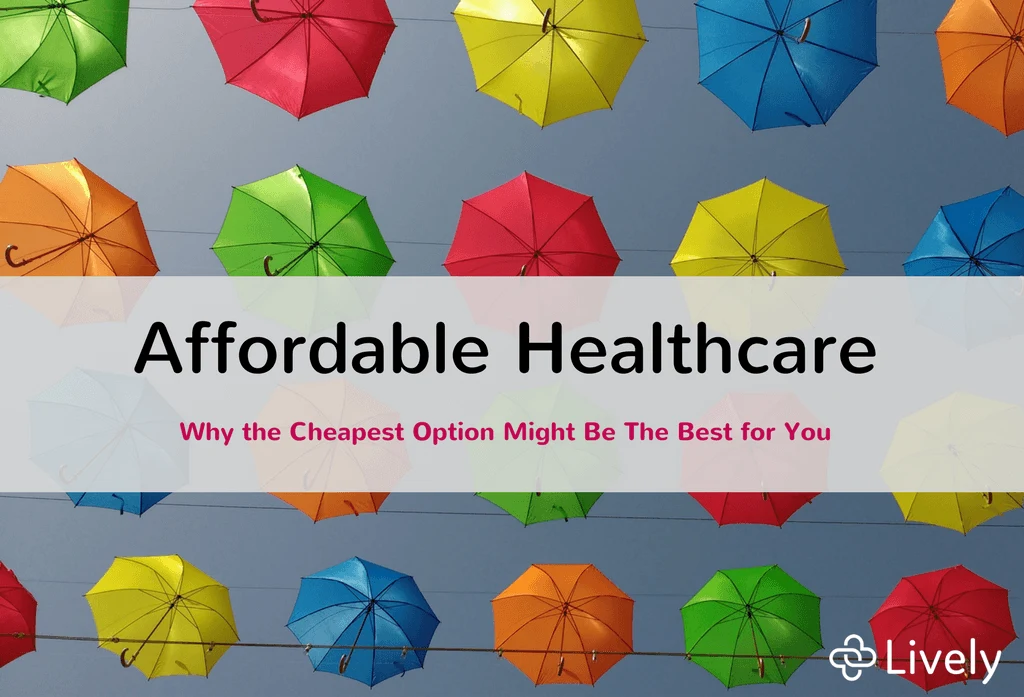The Lively Blog
SIGN UP FOR OUR
Newsletter
Stay up to date on the latest news delivered straight to your inbox
The Most Affordable Healthcare
Lively · July 27, 2017 · 3 min read

It seems that healthcare decisions are most often made for us, by others. As the healthcare debate continues to rage in the Senate, we wanted to help you understand why the cheapest health plan, might be the best.
Affordable Healthcare
High Deductible Health Plan (HDHPs) aren’t new to the American healthcare experience. They are however, becoming more popular, and now account for 29% of all employer sponsored US health plans. They typically have the lowest monthly premiums of any healthcare plan (both from employers and state exchanges). Their growing popularity isn’t surprising, as employers look to limit HR costs while still providing healthcare coverage (and options).
PPOs Still Reign Supreme
Most employees still select more coverage friendly plans like PPOs. They have been and continue to be lauded as the crème de la crème of healthcare plans. The higher the coverage rates, the better. PPOs have long stop atop other healthcare plans, but is it time to replace them on top of the podium?
What About The Long Term
We wouldn’t want to argue against the short term benefits PPOs provide. They create clear limits for expected health costs for the year. What about the years to come? PPOs and other plans like them provide no long-term healthcare planning tools or opportunities. Even if you are fit as a fiddle today, you need to plan for the future.
Enter the HDHP & HSA
We see the greatest value of an HDHP as the opportunity to couple it with an HSA. Why? HSAs are the only tool to provide long term health savings. A PPO by itself might outmatch a HDHP in the short term, but adding an HSA creates carry over the value that you can take with you from year to year, job to job and well into retirement.
The average Individual pays $936 for healthcare premiums/year for a HDHP and $1,237 for a PPO plan, after his or her employer contributions. For the employee, HDHPs offer a 24% average savings on premiums (vs. PPOs). HDHPs have higher deductibles, so keep that in mind.The individual can take that 24% difference in savings and use it to fund their HSA and by doing so:
Save tax-free dollars to pay for their deductibles and other health-related costs that year.
Save any unused HSA funds and keep that as a safe guard against future expected and unexpected health related costs.
In that sense, coupling an HDHP with an HSA is the only way to create a long-term health savings.
Affordable Plans Move to the Top
The key insight here is that by selecting the lower coverage (and premium option) of an HDHP you have the only option to save for healthcare for years to come. While a PPO might create the highest coverage option for this year, it provides no long-term savings options. If you change jobs, lose your job or retire, you lose the value of your PPO. By selected an HDHP and adding an HSA, you can save the dollars you would be putting into your PPO (don’t forget they are tax-free) and create a health nest egg for years to come. With an HSA, you can let your healthcare money work for you.
If you need more help with HSA decisions, check out our blog. We will make you a healthcare benefits expert in no time, without any extra work or effort on your end.

Benefits
2025 and 2026 HSA Maximum Contribution Limits
Lively · May 9, 2024 · 3 min read
On May 9, 2024 the Internal Revenue Service announced the HSA contribution limits for 2025. For 2025 HSA-eligible account holders are allowed to contribute: $4,300 for individual coverage and $8,500 for family coverage. If you are 55 years or older, you’re still eligible to contribute an extra $1,000 catch-up contribution.

Benefits
What is the Difference Between a Flexible Spending Account and a Health Savings Account?
Lauren Hargrave · February 9, 2024 · 12 min read
A Health Savings Account (HSA) and Healthcare Flexible Spending Account (FSA) provide up to 30% savings on out-of-pocket healthcare expenses. That’s good news. Except you can’t contribute to an HSA and Healthcare FSA at the same time. So what if your employer offers both benefits? How do you choose which account type is best for you? Let’s explore the advantages of each to help you decide which wins in HSA vs FSA.

Health Savings Accounts
Ways Health Savings Account Matching Benefits Employers
Lauren Hargrave · October 13, 2023 · 7 min read
Employers need employees to adopt and engage with their benefits and one way to encourage employees to adopt and contribute to (i.e. engage with) an HSA, is for employers to match employees’ contributions.
SIGN UP FOR OUR
Newsletter
Stay up to date on the latest news delivered straight to your inbox
